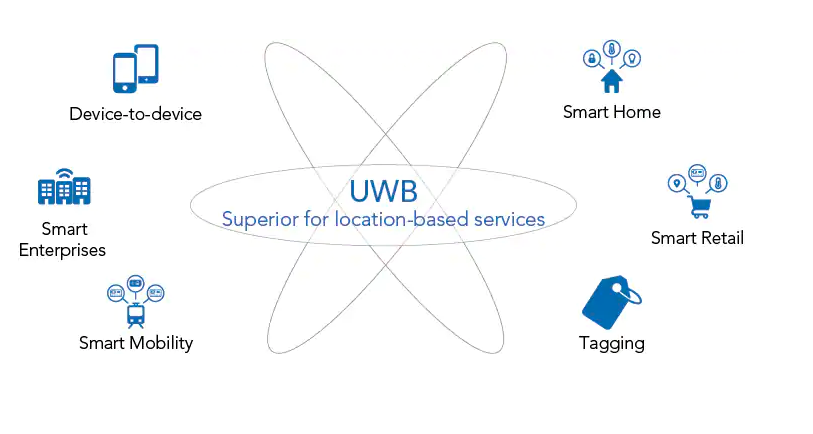Physical Address
304 North Cardinal St.
Dorchester Center, MA 02124

Ultra-wideband (UWB Ultra-Wide Band, ultra-wide band and ultra band) is a radio technology that can use a very low energy level for short-range, high-bandwidth communications over a large portion of the radio spectrum. UWB has traditional applications in non-cooperative radar imaging. Most recent applications target sensor data collection, precise locating, and tracking. UWB support started to appear in high-end smartphones in 2019.
Ultra-wideband is a technology for transmitting information across a wide bandwidth (>500 MHz). This allows for the transmission of a large amount of signal energy without interfering with conventional narrowband and carrier wave transmission in the same frequency band. Regulatory limits in many countries allow for this efficient use of radio bandwidth, and enable high-data-rate personal area network (PAN) wireless connectivity, longer-range low-data-rate applications, and the transparent co-existence of radar and imaging systems with existing communications systems.
Ultra-wideband was formerly known as pulse radio, but the FCC and the International Telecommunication Union Radiocommunication Sector (ITU-R) currently define UWB as an antenna transmission for which emitted signal bandwidth exceeds the lesser of 500 MHz or 20% of the arithmetic center frequency. Thus, pulse-based systems—where each transmitted pulse occupies the UWB bandwidth (or an aggregate of at least 500 MHz of a narrow-band carrier; for example, orthogonal frequency-division multiplexing (OFDM))—can access the UWB spectrum under the rules.

1. Secure keyless entry
While the technology has yet to be adopted by the entire automotive industry, it is being used more each year. BMW uses UWB for keyless entry in some of its newer vehicles, like the iX. One of the biggest advantages of using ultra wideband for digital keys instead of other technologies is that UWB is virtually attack-proof. While criminals can use specialized tools to break into other digitally-locked cars, they cannot do the same with cars locked using ultra wideband technology.
2. Automation
Self-driving cars need reliable and ultra-fast sensors to ensure that they aren’t about to accidentally drive full-speed into an abandoned JC Penney. What better technology to help driverless cars “see” what’s around them than UWB, which can emit one billion pulses per second and is accurate to within a few inches?
Like many other industries, UWB has yet to be fully utilized in autonomous cars, but we expect that to change quickly. Ultra-wideband is likely to be used to provide accurate, real-time information, back and forth from one connected car to another, quickly and accurately enough that a world full of driverless cars may actually be possible.
3. Manufacturing and logistics
It may not be the sexiest application for UWB technology, but it is one of the most impactful. Because UWB signals are so accurate and reliable, they can be used to track assets in factories, warehouses, and other large industrial sites. Think about it: finding a product in a large warehouse is a lot easier when you can track its location to the centimeter
4. Sports
Ever watched your favorite team or athlete lose a close matchup due to an officiating decision that you disagree with? Ever seen an offside penalty in a soccer game that you knew for a fact was called wrong, and it cost your team the match? Ultra-wideband will eventually make bad calls a thing of the past.
UWB is already being used in the NFL to track player locations for stats and officiating. UWB antennas are even being placed inside footballs, updating the ball’s location 2,000 times per second. Expect to see more advanced insights, officiating, and animations when you watch sports in the future, all powered by ultra-wideband.
5. Asset Tracking
Personal item trackers like the Apple AirTag use UWB technology to pinpoint the exact location of an item. Boeing also uses UWB technology to keep track of thousands of expensive tools, parts, and equipment in its factories.
These are examples of asset tracking. Using wireless tracking technology can help ensure nothing valuable goes missing again. Lost inventory and supplies are expenses that really add up, and companies like Boeing have realized that they can use UWB tracking to cut down on this.
5. Smart Homes
We love smart homes here at Android Authority, and the potential for UWB in this area is pretty awesome. Just imagine how nice it would be if your home’s lights were triggered automatically every time you walked into a room with your UWB-equipped phone in your pocket. Another cool use for UWB would be the ability to program your front door to unlock automatically when you are within 10 feet of the door — and those are just two of the dozens of ways that ultra-wideband can make smart homes even smarter.
Even better, imagine you lose your phone somewhere in your house. Instead of searching underneath every couch cushion and praying that you didn’t put your phone in the washing machine, you could simply ask Amazon Alexa where your phone is. With UWB, your digital assistant could tell you exactly where your phone was in a fraction of a second!
